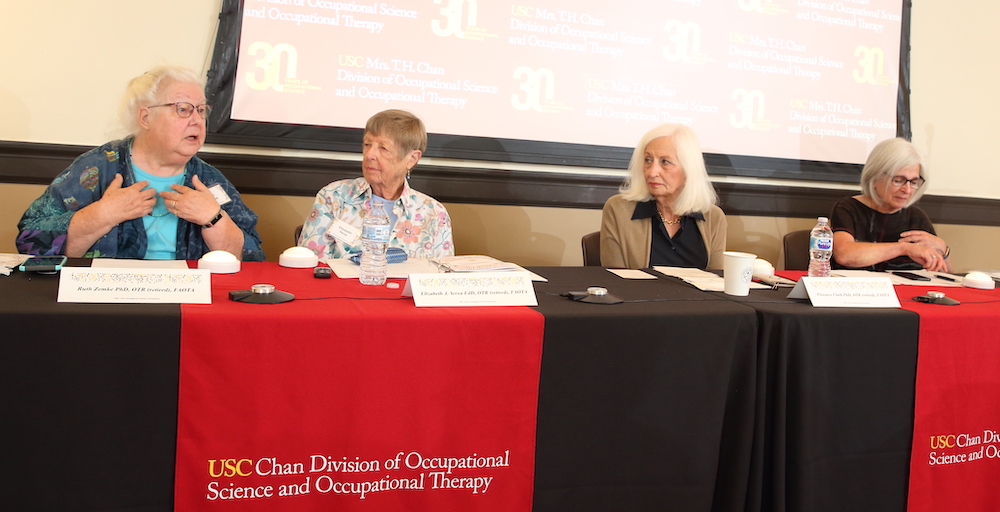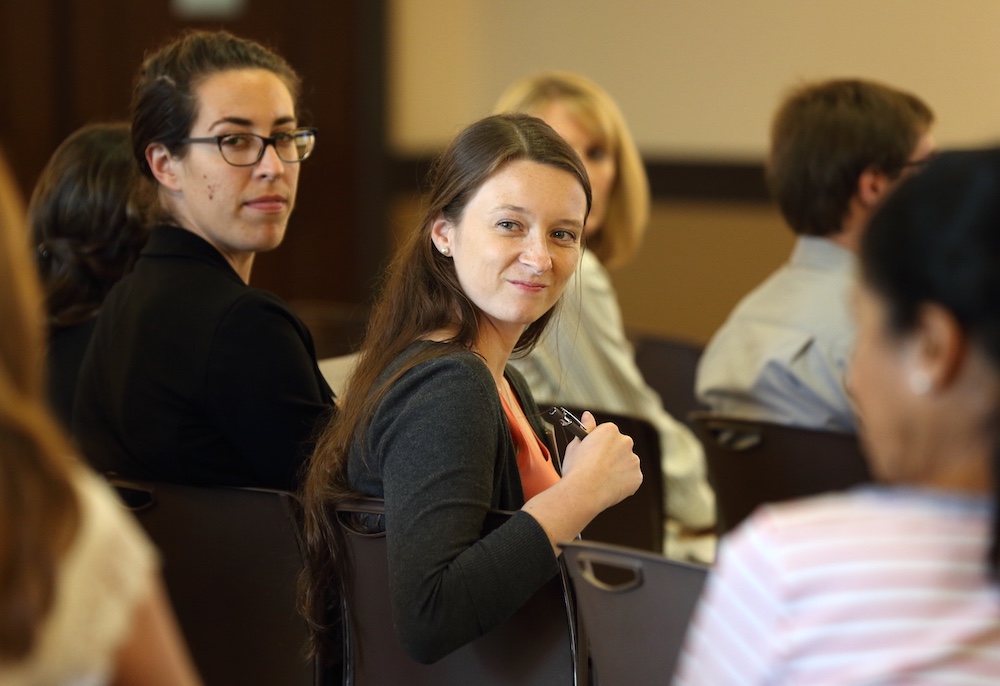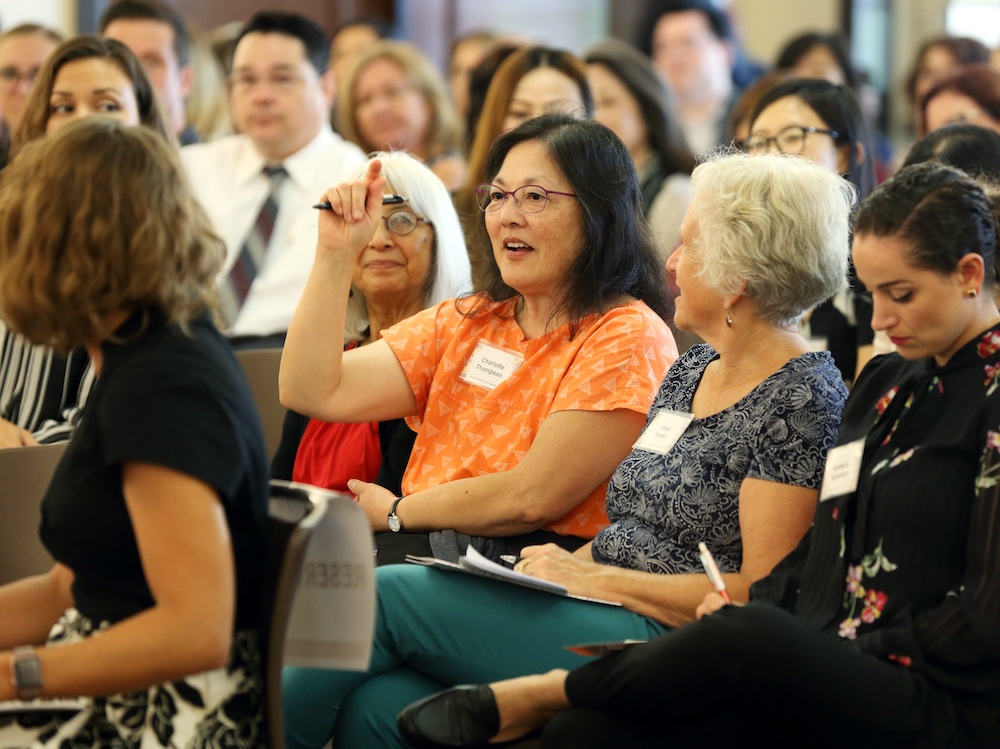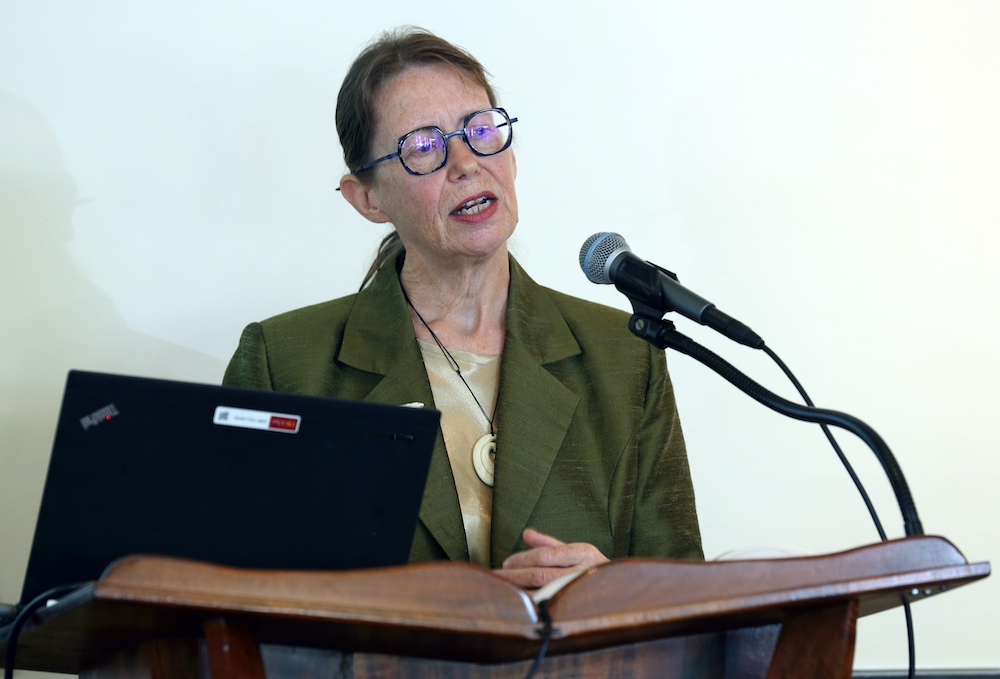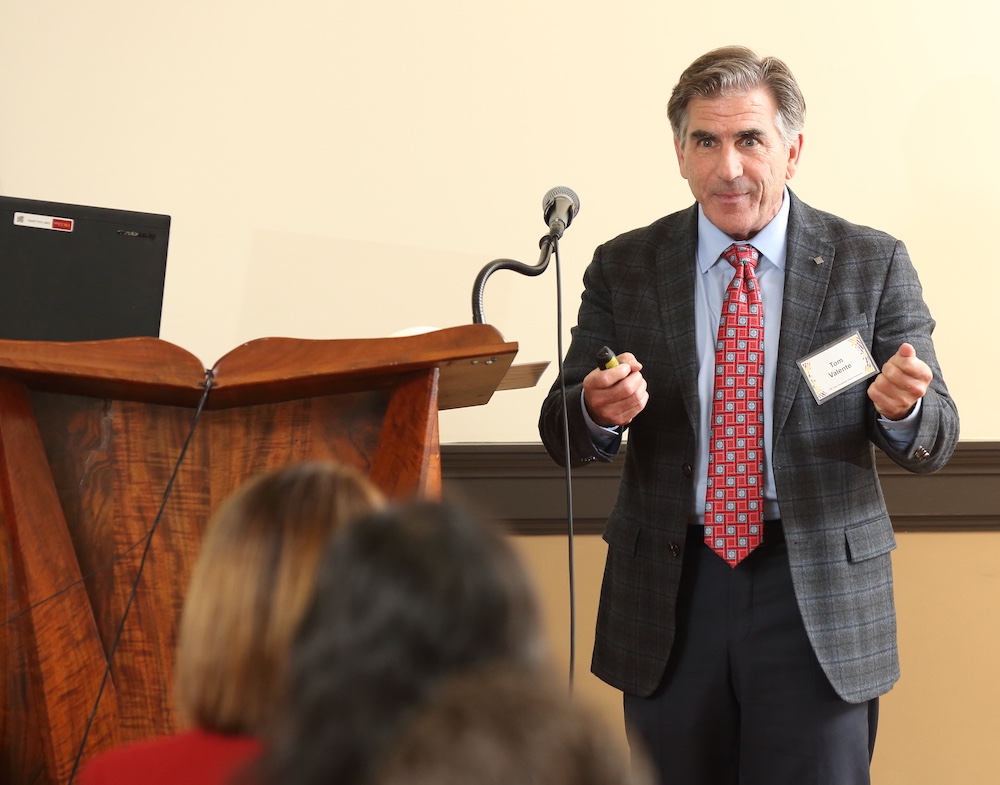A Science of Hope
How our audacious community of scholars created occupational science.
By Elizabeth J. Yerxa ’52, MA ’53, Professor Emeritus of Occupational Science and Occupational Therapy
(Based on prepared remarks that introduced the “Founders Panel” during the September 2019 USC Chan Occupational Science Symposium.)
I invite you to time travel with me, back to 1987, when the proposal for a new Doctor of Philosophy Degree in Occupational Science was submitted to the Graduate School at the University of Southern California.
Our small faculty were located in old wooden barrack buildings, on an otherwise abandoned site at Rancho Los Amigos Hospital, with no control over our space or our budget. We recognized both our vulnerability in the university and our commitment to occupational therapy and the rich academic traditions of our department, personified by former Department Chair Margaret Rood; A. Jean Ayres ’45, MA ’54 and Mary Reilly ’51. Over a span of eight years we had become a community of scholars, devoted to understanding occupation, with the goal of translating that knowledge into a new scholarly degree.
Mary Reilly once remarked that occupational therapists have an optimistic view of human nature — how true! We were audaciously optimistic because we saw the potential contribution of what we called “occupational science” to the universe of knowledge constituting the university and, thus, to the people served by our profession. Let us explore the context in which our effort took place within the profession, the university and the department.
The profession in crisis
In the 1980s, occupational therapy was experiencing a sort of Kuhnian crisis regarding its knowledge base and practice. It seemed possible that the concept of “occupation” might disappear from occupational therapy, to be replaced by technique and modality.
Such reduction also threatened to weaken or eliminate mental health practice. Leaders in the profession recognized that we needed to know much more about the occupational human before we could develop comprehensive theories of intervention to provide practitioners with the knowledge they needed to better serve humankind. Mary Reilly had led the way at USC by developing the occupational behavior frame of reference. Her master’s students’ theses each explored some aspect of occupation as basic knowledge which was then applied to practice through case method.
In 1985, only 17 percent of occupational therapy faculty nationally held doctoral degrees, a paucity that limited scholarship and made our schools vulnerable in universities. Since only one small PhD program existed at New York University, most occupational therapy faculty seeking doctorates had to pursue them in other disciplines, contributing their research to that field, not occupational therapy. A new scholarly degree in occupational science would enable faculty to expand and deepen the knowledge base of the profession, and ensure the relevance of their research to the core questions of the field.
Back at USC, as we revised the master’s curriculum and developed faculty research programs, it became obvious that we needed a conceptual framework for organizing the vast knowledge of occupation and enabling research to contribute new ideas to practice. Simultaneously, leaders from both the American Occupational Therapy Association and the American Occupational Therapy Foundation urged our USC faculty to develop such basic knowledge.
Through several years of argument, study, experimentation and discovery of resources, we developed a multi-leveled systems model of the occupational human, interacting with the environment, over the three time spans of learning, development and evolution. This became the organizing framework for the PhD curriculum, and our response to the threat of reductionism.
The maturing university
As USC became a major research university around this time, several of its academic departments were scrutinized to assess their contribution to research and scholarship. Some were discontinued because they were deemed too technical. This possibility became a crucial issue for us due to both our lack of visibility in the university and the corresponding lack of understanding of our discipline. As we further developed occupational science, we recognized that becoming an academic discipline would enable our department to contribute significantly to achieving the university’s goals.
Thus, we developed a plan to establish collegial relations with other relevant disciplines, engage in collaborative research and become recognized for our scholarship. To this end, we established strong relationships with the College of Letters, Arts and Sciences, culminating in a university-wide presentation of our occupational science conceptual framework and plans for developing the new PhD curriculum. We called this our “polymath” meeting since all faculty members invited were distinguished scholars, some in several fields. At the close of the meeting, the consensus of this esteemed group was that we should move ahead with our mission: developing the PhD and contributing our knowledge to other disciplines. Both of the deans of the College of Letters, Arts and Sciences — Irwin “Chet” Leib, a philosopher, and Paul Bohannon, an anthropologist — got the potential value of occupational science to the university from the very beginning.
The department’s vision realized
The departmental context was one of excitement, deliberation and urgency to contribute new knowledge through our research. We wanted to study the occupational human and the relationship between engagement in occupation and health; to restore occupation as central to occupational therapy; and to support the new doctoral program and secure our place within the university.
Our master’s students urged us to develop the PhD curriculum because there was so much more to learn about occupation than could possibly be transmitted at the Master of Arts level. We anticipated that our research, organized into a systems model, would be integrated into the curriculum at all levels, providing practitioners with the new knowledge they needed to support their work.
We were adamant that the research methods we employed neither demeaned nor diminished the people we studied, but reflected humanistic values and emphasized people’s experiences and satisfaction with engagement in occupation. Thus, sometimes we needed to employ creative new research approaches. We also wanted to understand much more about the developmental trajectory by which people develop competence. Consequently, our research needed to encompass the entire lifespan — what a challenge!
The PhD proposal completed in 1987 resulted from the sustained efforts of our faculty consisting of Professor Emeritus Florence Clark; Professor Emeritus Ruth Zemke; Diane Parham MA ’81 who coordinated the development of the proposal; Professor Gelya Frank; Doris Pierce MA ’88, PhD ’96; Carol Stein ’81, MA ’84 and Jeanne Jackson MA ’86, PhD ’95. To introduce it, we co-authored a paper, “An Introduction to Occupational Science, a Foundation for Occupational Therapy in the 21st Century,” published in a special issue of Occupational Therapy in Health Care devoted entirely to occupational science. The issue’s “Foreward” was written by psychologist Mihaly Csikszentmihalyi, a consultant and an enthusiastic supporter of our efforts.
In the earlier, formative years of our thinking, Jerry Sharrott MA ’80, Bob Wolf (an anthropologist), Linda Davis and Doris Hill MA ’69, who connected us to Mary Reilly’s work, made substantial contributions. Many of our master’s students’ theses centered upon occupation, fitting within individual faculty member’s research programs. Our clinical faculty contributed substantially via thesis research and consultation. Janice Matsutsuyu MA ’68; USC Chan Board of Councilors Chairperson Linda Florey MA ’68, PhD ’98; Janice Burke MA ’75 and the occupational therapists at Rancho Los Amigos Hospital were particularly supportive. Stan Azen, a biostatistician, was central to our research efforts. He was open to the complexity of occupation and found valid, creative ways for us to operationalize key concepts!
A related effort was seeking to relocate the department to a more visible and intellectually appropriate setting. Echoing the founders and reflecting the content and values of our basic science, we sought to become part of the College of Letters, Arts and Sciences and to relocate to the USC University Park Campus. With the encouragement of the dean of LAS and the LAS department chairs, we explored several possible locations there. However, in early 1988, the provost of the university made such a move impossible. Shortly thereafter, I retired from my position, having seen the initial version of the PhD proposal submitted and approved by the relevant department chairs and administrators.
I am extremely indebted to those who came before us at USC, those audacious colleagues who believed in and worked diligently to create occupational science, and those — especially Drs. Clark and Zemke — who implemented it so successfully. Dr. Florence Clark’s courageous, energetic and steadfast leadership, and Dr. Ruth Zemke’s lucid, grounded interpretation, enabled our vision to be realized as it is in the world today: occupational science, not as a science of pathology, but as a science of hope.
The “Founders Panel” at the 2019 USC Chan Occupational Science Symposium featured (from left to right) Professor Emeritus Ruth Zemke, Professor Emeritus Elizabeth Yerxa ’52, MA ’53, Professor Emeritus Florence Clark PhD ’82 and panel moderator Janice Burke MA ’75 | Photo by Glenn Marzano
The 2019 USC Occupational Science Symposium
September 19, 2019, was a day literally 30 years in the making. At the 2019 USC Occupational Science Symposium, more than 150 scholars, educators, clinicians and alumni came to campus to commemorate the 1989 founding of the world’s first PhD in occupational science degree program, and to mobilize for what might lie ahead.
It was also, in another sense, a day nearly one year in the making. A team including Associate Clinical Professor Rebecca Aldrich ’05, MA ’06, staff member Jeanine Blanchard MA ’99, PhD ’10, and students Catherine Shin MA ’19, OTD ’20 and Natasha Strickland MA ’18, OTD ’19 planned the symposium throughout 2019.
The event opened with remarks by a distinguished panel of occupational science’s founders — Professors Emeriti Florence Clark PhD ’82; Elizabeth Yerxa ’52, MA ’53; and Ruth Zemke — moderated by Janice Burke MA ’75, co-founder of the Model of Human Occupation. All four were named to the American Occupational Therapy Association’s 2017 list of the 100 most influential people in the all-time history of occupational therapy. The panel recounted the formative years of the discipline, transporting the audience back to Rancho Los Amigos National Rehabilitation Hospital, where the educational program was located from 1972 to 1988 and the USC Graduate School in the 1980s.
Associate Chair of Research and Professor Mary Lawlor then spoke about applying a narrative approach for telling the discipline’s unifying story, and Associate Dean and Chair Grace Baranek discussed occupational science through the lens of meliorism: the metaphysical belief that humans, through their actions in and upon the world, have the capacity to make life better for individuals, groups and societies.
Six USC Chan faculty members gave conference-style research briefs about their current projects, a panel featuring USC alumni who hold faculty appointments at international institutions in Canada, Japan, Sweden and Taiwan discussed the discipline’s global developments and three participatory breakout sessions explored translational applications of occupational science to clinical, educational and social contexts.
Clare Hocking (pictured above), professor at New Zealand’s Auckland University of Technology, delivered the honorary Wilma West Lecture titled “Occupation in Context: A Reflection on Environmental Influences on Human Doing.” Hocking’s scholarship focuses on occupational justice and occupation for population health, and her current research includes identifying strategies that people with health conditions use to manage participation in everyday occupations at home and in the community.
Thomas Valente (pictured above), professor and interim chair of Preventive Medicine at the Keck School of Medicine of USC, gave the keynote lecture on “Social Networks and the Spread of New Ideas and Practices.” Valente uses social network analysis, health communication and mathematical models to implement and evaluate health promotion programs. The day closed with a screening of “30 Years of USC Occupational Science,” a documentary-style video now available on YouTube, and a hosted reception at the USC Center for Occupation and Lifestyle Redesign along with tours of the newly opened USC Chan Archive.
Three decades ago, the symposium was imagined as being the division’s marquee academic and networking event to foster the growth of the fledgling new discipline. As occupational science enters its fourth decade, the USC Chan OS Symposium continues carrying that legacy forward for the next generation.
At the 2019 USC Chan Occupational Science Symposium, more than two dozen alumni of the PhD in Occupational Science program gathered to celebrate three decades of the discipline, including (back row, left to right): Eric Asaba, Don Gordon, Julie McLaughlin Gray, Christy Billock, Melissa Park, Linda Florey, John White, Erna Blanche, Susan Knox, Susan Spitzer, Megan C. Chang, Thomas Mernar, Alison Cogan, Beth Pyatak, Mark Hardison; (front row, left to right): Amber Angell, Jin-Ling Lo, Yan-Hua Huang, Etsuko Odawara, Bonnie Kennedy, Sheama Krishnagiri, Phyllis Meltzer, Pollie Price and Jeanine Blanchard | Photo by Glenn Marzano
⋯







